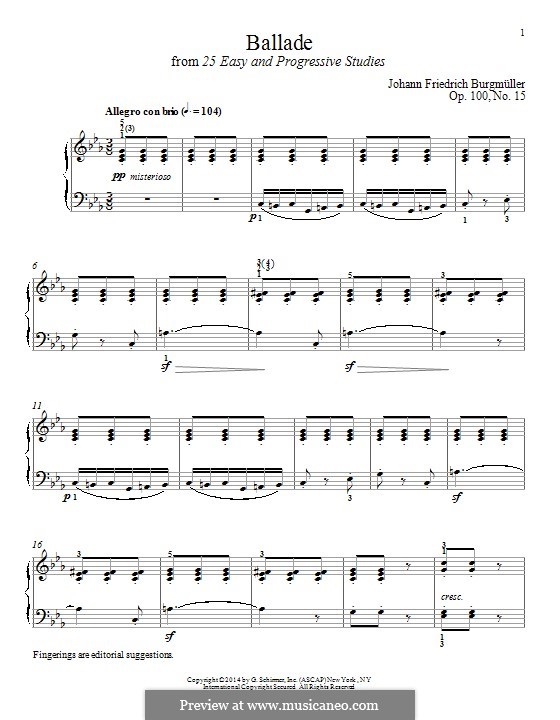Burgmuller Op 109 Pdf To Excel

Personally I don´t think Op. 105 is musically on the same level as Op. Possibly with this set, Burgmuller decided to keep close to the etude form, and explore particular technical difficulties on each (while on op. 109 each piece addresses several technical problems). I only really like (as pieces of music) no. Johann Friedrich Burgmuller - 18 Characteristic Studies, Op. 109 Piano Solo, Piano Method (Piano edited and recorded by William Westney Schirmer Performance Editions). EMBED (for wordpress.com hosted blogs and archive.org item tags).
Interesting idea, but we'd never be able to get general agreement as to what grade a particular piece fits into. It doesn't have to be exact. Just 'about' grade something. Weeden And Zygmund Pdf Free there. Some years ago I started to keep a database of pieces by grade.

They are taken from past syllabi of ABRSM and Trinity and Guildhall so are what the exam boards think the grades are for the pieces. I've not updated it for quite some time, but here it is, if it is of any use. I haven't used all of them but I do use quite a lot of myself when looking for pieces at a certain level and have found lots of them are very popular. Already I disagree!!!
Beethoven Moonlight is diploma standard for the whole sonata, and the Chopin Nocturne in Eb is harder than grade 6 - nearer grade 8 to play it well. And the Minute Waltz - a grade 7 wouldn't have the control of fingers at the speed required.The problem with a lot of music is not the grade you need to be to 'get your fingers somehow round the notes' but the grade you need to be to play it well.. I have my own database (a bit like jm-hamilton) based on old grade pieces from the ABRSM lists going back for however many years..and even then there are problems - for example, the Handel Fantasia in C major appearing on last year's(?) grade 7 list was one of my grade 6 pieces when I did my grade 6 exam years back.!!! How do the exam boards grade pieces? Can one of the examiners enlighten us? Grading has to be based, I would guess, on a set of objectives which may categorise a piece that looks easy in terms of key/time signatures, to a higher grade because of the difficulty of the fingering or number of notes/chords and their compexity or whatever.
How does a piece graded 5 or 6, say 5 years ago, now become a seven or eight?? After I passed grade 8 I ceased to care about such things and just got on with playing the music whether or not I found it easy or hard. I have a list that I put into excel, taken from something I found on the net as guidance for examiners of the GCSE A/levels. It has 826 pieces listed. Pm me you email addy if you are interested in a copy of my excel sheet Oh, and I also have The Pianist's Guide to Standard Teaching and Performance Literature by Jane Magrath. Big thick book with short notes and grade recommendations.
Okay.it put it from Grade 1-10, but can give an idea of what sort of standard is expected. Great book for the library. One to dip into forever. Interesting idea, but we'd never be able to get general agreement as to what grade a particular piece fits into. It doesn't have to be exact. Just 'about' grade something.
I am just starting one etude from op. I only know that the no.12 from op.109 is good for practising broken octaves and no.
6 is for hand stretching. No.2 has scales. Each etude consentrates on a certain technical difficulty. What I like about these etudes is that they're also very melodical; they are much more than exercises.
I haven't seen the op. I hope someone else will reply, too because I really know very little about them. I just got the book couple of days ago. Do you find this post useful? If there is anyone out there who has used these studies, could you be kind enough to please explain what the point of these etudes might be? Serial Key Kane And Lynch 2 Review. What kind of techniques etc do they aim at cultivating?